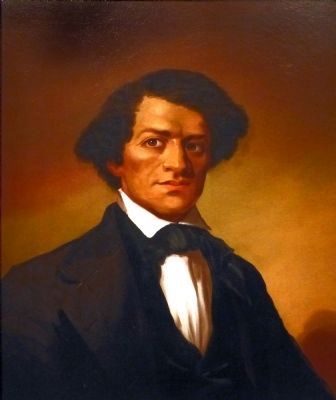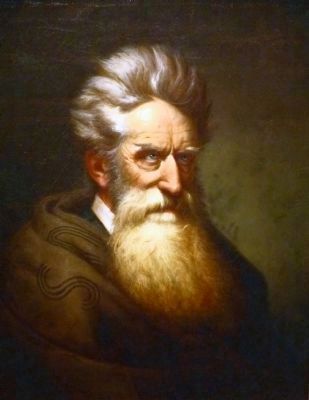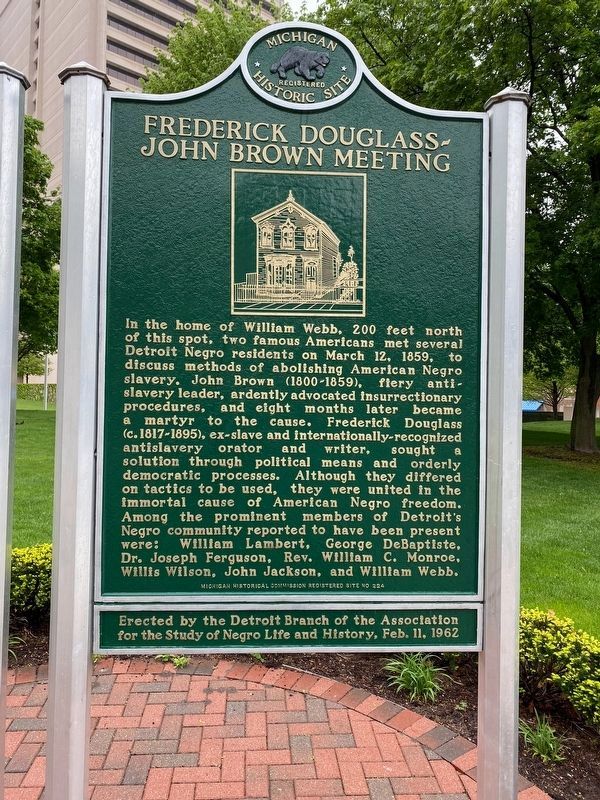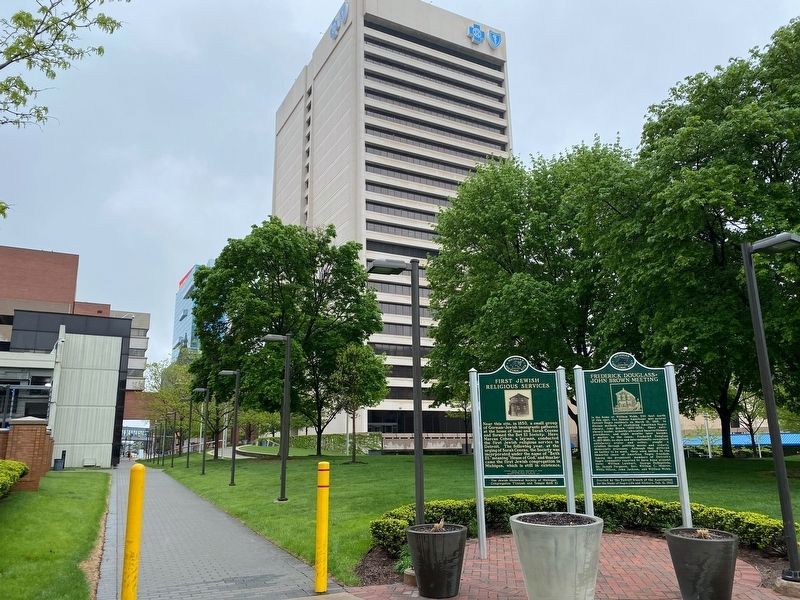Downtown Detroit in Wayne County, Michigan — The American Midwest (Great Lakes)
Frederick Douglass - John Brown Meeting
Erected 1962 by State of Michigan. (Marker Number S0224.)
Topics and series. This historical marker is listed in these topic lists: Abolition & Underground RR • African Americans • Civil Rights. In addition, it is included in the Michigan Historical Commission series list. A significant historical date for this entry is March 12, 1859.
Location. 42° 19.987′ N, 83° 2.36′ W. Marker is in Detroit, Michigan , in Wayne County. It is in Downtown Detroit. Marker is at the intersection of St. Antoine Street and Congress Street on St. Antoine Street. Touch for map. Marker is in this post office area: Detroit MI 48226, United States of America. Touch for directions.
Other nearby markers. At least 8 other markers are within walking distance of this marker. First Jewish Religious Services (here, next to this marker); SS. Peter and Paul Church (about 600 feet away, measured in a direct line); Detroit Cornice and Slate Building (about 600 feet away); Chapoton House (about 600 feet away); Holy Family Church (about 700 feet away); George DeBaptiste Homesite (about 700 feet away); Church of Annunciation (approx. 0.2 miles away); St. Mary's Church (approx. 0.2 miles away). Touch for a list and map of all markers in Detroit.
Also see . . . D is for... Frederick Douglas - Chester County Historical Society. (Submitted on December 9, 2011, by Keith S Smith of West Chester, Pennsylvania.)

3. Frederick Douglass
This 1844 portrait of Frederick Douglass hangs in the National Portrait Gallery in Washington, DC.
“Frederick Douglass became the first nationally known African American in U.S. History by turning his life into a testimony on the evils of slavery and the redemptive power of freedom. He had escaped from slavery in 1838 and subsequently became a powerful witness for abolitionism, speaking, writing, and organizing on behalf of the movement; he also founded a newspaper, the North Star. Douglass's charisma derived from his ability to present himself as the author of his own destiny at a time when white America could barely conceive of the black man as a thinking and feeling human being. The Narrative of the Life of Frederick Douglass is not only a gripping nonfiction account of one man's struggle for freedom; it is also one of the greatest American autobiographies. This powerful portrait shows Douglass as he grew in prominence during the 1840s.” — National Portrait Gallery.
“Frederick Douglass became the first nationally known African American in U.S. History by turning his life into a testimony on the evils of slavery and the redemptive power of freedom. He had escaped from slavery in 1838 and subsequently became a powerful witness for abolitionism, speaking, writing, and organizing on behalf of the movement; he also founded a newspaper, the North Star. Douglass's charisma derived from his ability to present himself as the author of his own destiny at a time when white America could barely conceive of the black man as a thinking and feeling human being. The Narrative of the Life of Frederick Douglass is not only a gripping nonfiction account of one man's struggle for freedom; it is also one of the greatest American autobiographies. This powerful portrait shows Douglass as he grew in prominence during the 1840s.” — National Portrait Gallery.

4. John Brown
This 1872 portrait of John Brown by Ole Peter Hansen Balling hangs in the National Portrait Gallery in Washington, DC.
“There were those who noted a touch of insanity in abolitionist John Brown; he believed he had been called by God to embark on a personal crusade to end slavery. Brown and five of his sons were actively engaged in the bloody guerrilla war being waged in Kansas in 1855-56, between proslavery and anti-slavery factions. But in 1857, Brown began making plans for the 1859 raid on the federal arsenal at Harper's Ferry, an event that would make him both infamous and immortal. The scheme to commandeer firearms with which to arm a slave rebellion failed, and Brown was captured, tried, and hanged. His insurrection found favor among many northern abolitionists. In response, southerners viewed Brown as a sign that they must either break their allegiance to the Union or be destroyed by an increasingly fanatical North. ” — National Portrait Gallery
“There were those who noted a touch of insanity in abolitionist John Brown; he believed he had been called by God to embark on a personal crusade to end slavery. Brown and five of his sons were actively engaged in the bloody guerrilla war being waged in Kansas in 1855-56, between proslavery and anti-slavery factions. But in 1857, Brown began making plans for the 1859 raid on the federal arsenal at Harper's Ferry, an event that would make him both infamous and immortal. The scheme to commandeer firearms with which to arm a slave rebellion failed, and Brown was captured, tried, and hanged. His insurrection found favor among many northern abolitionists. In response, southerners viewed Brown as a sign that they must either break their allegiance to the Union or be destroyed by an increasingly fanatical North. ” — National Portrait Gallery
Credits. This page was last revised on February 12, 2023. It was originally submitted on December 16, 2008, by Al Barrera of Brownstown, Michigan. This page has been viewed 3,452 times since then and 140 times this year. Last updated on March 17, 2021, by Carl Gordon Moore Jr. of North East, Maryland. Photos: 1. submitted on May 4, 2021, by J.T. Lambrou of New Boston, Michigan. 2. submitted on May 29, 2021, by J.T. Lambrou of New Boston, Michigan. 3, 4. submitted on May 2, 2015, by Allen C. Browne of Silver Spring, Maryland. • Bill Pfingsten was the editor who published this page.

